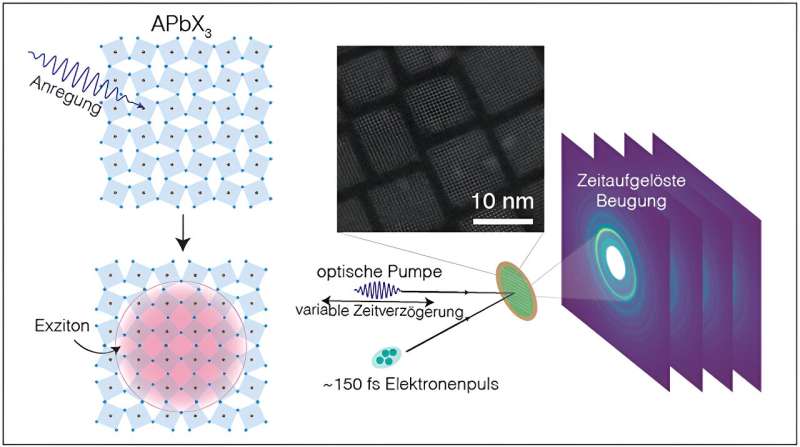The international research team found that excited electrons (in the center of the image) can straighten the misaligned crystal lattice of perovskite nanocrystals. Source: Nouri Yasdani / ETH Zurich
Researchers from ETH Zurich, Empa and Stanford have captured snapshots of the crystal structure of perovskite nanocrystals as they are deformed by excited electrons. To their surprise, the deformation straightened the skewed crystal structure rather than making it more disordered.
Many scientific and technical problems could be easily solved if it were possible to look inside matter and watch its atoms and electrons vibrate in real time. In the case of halide perovskites, a class of metals that have become very popular in recent years for use in technologies ranging from solar cells to quantum technologies, physicists have long tried to understand their excellent optical properties.
A team of researchers led by Nouri Yazdani and Vanessa Wood at ETH Zurich, and Aaron Lindenberg at Stanford University, along with their colleagues at Emba in Dübendorf, have made significant progress toward our understanding of perovskites by studying the movement of atoms inside nanocrystals over time. Accuracy of a few billionths of a second. they Recently published Their findings in Nature physics.
“Halide perovskites are great for many optoelectronic applications,” says Yazdani. “But it is in some ways puzzling how this class of materials can exhibit such outstanding optical and electronic properties.” Perovskites are minerals that have the same type of crystal structure as calcium titanate (CaTiO).3), the “native” perovskite.
The researchers knew that when perovskites absorb light, electrons excited to higher energies are strongly coupled to phonons within the material. Phonons are collective vibrations, similar to sound waves, of atoms in a crystal. “Often one can treat the average position of each atom within a crystal as a constant, but this is no longer possible when photoexcitation of an electron leads to a significant reorganization of the crystal lattice,” Yazdani explains. Therefore, the question the researchers had to answer was: How do excited electrons in perovskite change the shape of the crystal lattice?

When perovskite absorbs a photon, the resulting exciton flattens the misaligned crystal lattice (left). The researchers captured snapshots of this process by measuring the diffraction of a very short electron pulse at different times after the photon was absorbed (right). Source: Nouri Yasdani / ETH Zurich
Looking inside nanocrystals
To get a glimpse of the perovskite (formidinium lead bromide) synthesized at Emba by Marina Bodnarchuk and ETH Professor Maxim Kovalenko, the researchers used an ultrafast electron diffraction beamline facility at Stanford National Accelerator Laboratory (SLAC) that produces very short, long-lasting pulses of electrons. Just a hundredth of a femtosecond, or a millionth of a millionth of a second. These electrons then collide with perovskite nanocrystals, which are about 10 nanometers in size, and the deflected electrons are collected on the screen.
Since electrons are quantum particles that behave like waves, after they are diffracted by atoms inside the material, the electron waves interfere constructively or destructively, depending on the positions of the atoms and the direction of the diffraction, just like light emerging from a double slit. Even small changes in crystal structure can be measured in this way.
The researchers at ETH used a special feature of the SLAC beamline to capture snapshots of the crystal structure during and after photon absorption: using the same laser to create the photons and stimulate the electron pulse, they were able to control the arrival time of the photon to the nanocrystals relative to the arrival time of the electrons by varying the distance they had to travel. Photons. By analyzing these snapshots over several hundred picoseconds (billionths of a second), it was possible to see how the distortion of the crystal lattice caused by the photo-excited electrons evolved over time.
A sudden increase in symmetry
The results surprised the researchers. They expected to see a distortion in the crystal lattice that should have led to a decrease in its symmetry. Instead, they observed a shift toward increased symmetry, as the excited electrons straightened the perovskite’s slightly skewed crystal structure.
From model calculations, they were able to deduce that many excitons – bound pairs of excited electrons and the positively charged holes left by their excitation – could cooperate in straightening the lattice. Since this reduces their total energy, the excitons are effectively attracted to each other.
Tailoring the optical properties of perovskites
“Understanding the origin of electron-phonon coupling will make it easier to produce perovskites with specific optical properties tailored to specific applications,” says Yazdani. For example, perovskite nanocrystals used in next-generation television displays could be coated with a coating of another material in order to reduce electron-phonon coupling, thus reducing the spectral linewidth of the emitted light. This was really it Shown in 2022 By several co-authors Nature physics paper.
Also, since the attractive interaction between excitons is similar to the mechanism that allows electric current to flow losslessly in superconductors, this attraction may be exploited to enhance electron transfer. This, in turn, may be useful in making perovskite-based solar cells.
more information:
Nouri Yazdani et al., Octahedral tilt coupling in halide perovskite nanocrystals induces attractive phonon-mediated interactions between excitons, Nature physics (2023). doi: 10.1038/s41567-023-02253-7
the quote: Researchers show that excited electrons straighten the skewed lattice of perovskite nanocrystals (2023, December 4) Retrieved December 4, 2023 from https://phys.org/news/2023-12-electrons-straightening-skewed-lattice-perovskite .html
This document is subject to copyright. Notwithstanding any fair dealing for the purpose of private study or research, no part may be reproduced without written permission. The content is provided for informational purposes only.












































